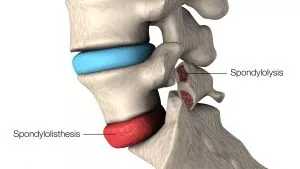
SPONDYLOLISTHESIS
With more children participating in competitive sports every year for longer periods of time, we see a growing number of Spondylolisthesis patients. Sports has become a common cause of lower back pain among children and adolescents. To clarify, It is usually a mild case and treated conservatively.
Stretching for 30 minutes before participating in sports in growing children can prevent injury.
Spondylolisthesis
 Spondylolisthesis refers to a sports injury in children, usually associated with Hyperextension. Hyperextension happens when a child is playing or participating in sports, and their spine becomes forced backward into an exaggerated arch. When this happens frequently it can cause a slipped vertebrae or Spondylolisthesis. Also, it is becoming more common among children who participate in gymnastics, football, or wrestling. Sports injuries in children have been increasing over the years as children play longer and more competitively.
Spondylolisthesis refers to a sports injury in children, usually associated with Hyperextension. Hyperextension happens when a child is playing or participating in sports, and their spine becomes forced backward into an exaggerated arch. When this happens frequently it can cause a slipped vertebrae or Spondylolisthesis. Also, it is becoming more common among children who participate in gymnastics, football, or wrestling. Sports injuries in children have been increasing over the years as children play longer and more competitively.
Specifically, spondylolisthesis is a condition in which one of the bones of the spine (vertebrae) slips out of place. The slipped vertebrae slips off in front of the vertebra below it. If it slips too much, the bone can press on a nerve causing pain in the lower back. In addition, severe pressure on the nerves may also cause bladder dysfunction.
How Common Is Spondylolisthesis?
Spondylolisthesis is not an uncommon cause of back pain in teens and they can begin showing symptoms during a growth spurt. Furthermore, sports can cause a lower back strain that can contribute to a slipped vertebrae. Therefore, warm-up and stretching, especially during the growing years, are vitally important to keeping your child spine healthy.
Our physicians at Medical City Children’s Orthopedic and Spine Specialists take care of all types of sports-related injuries including Spondylolisthesis. In case of an injury, we can examine your child right away. Also, you never have to wait long for an appointment. With convenient locations in Arlington, Dallas, Flower Mound, Frisco, and McKinney, TX, we are never far away.
Symptoms
Oftentimes children and adolescents with spondylolisthesis don’t have any pain. They don’t even know they have the condition. When symptoms do occur, the most common one is low back pain, because of the slipped vertebrae. The pain often spreads across the lower back. It may feel like a muscle strain. Spondylolisthesis can also cause muscle spasms in the hamstring muscles in the back of the thighs. Tight hamstrings can cause a child to walk with short strides and with the knees slightly bent. If the slipped vertebra is pressing on a nerve, the pain might spread down the leg to the foot. The foot might also tingle and/or feel numb.
Diagnosis
To diagnose Spondylolisthesis, an examination and an X-ray of the lower back will be performed. It can identify any slipped vertebra, ones that are out of alignment. However, your doctor may order more tests if a more detailed image is needed. If so, a computed tomography (CT) scan or a magnetic resonance imaging (MRI) scan may be ordered.
Spondylolisthesis is becoming more common among teenagers.
“With spondylolisthesis, when the vertebra slips out of place before the age of ten, research indicates, it is more likely to cause a bigger slip as teenagers. With our experience and training, we understand the complexities of growth plates for children’s growing bones and how best to treat them.” Shyam Kishan, MD
Treating Spondylolisthesis
Treating spondylolisthesis depends on several factors:
- Age and overall health of the child
- The extent of the slippage
- The severity of the symptoms.
Treatment is most often conservative. A more severe condition of spondylolisthesis may require surgery.
Conservative treatment
This involves rest, medication, and moderate exercise. Taking a break from sports and other activities until the pain subsides. A non-steroidal, anti-inflammatory medicine purchased over the counter, might be recommended. This would possibly help to reduce pain and inflammation. If it doesn’t provide pain relief, a stronger medication might be needed. Thus, your doctor may prescribe an epidural steroid injection. The injection places medication directly in the space surrounding the spine, by the slipped vertebrae. These types of injections may help reduce inflammation and ease the pain.
Bracing
A back support or brace can help stabilize the lower back while it’s healing. It also might help with reducing pain. An exercise and/or physical therapy program can help as well. Support and increasing pain-free movement will improve flexibility and muscle strength. We periodically take X-rays to determine if bone slippage is still happening.
Physical therapy
An exercise program that strengthens the abdominal and/or back muscles thus minimizing the bony movement of the spine is normally prescribed. We generally recommend 8 to 12 weeks of aggressive, daily stabilization exercises. These exercises help to achieve clinical improvement. Focusing on stretching tight hamstrings, as well as core and spine extensor muscle strengthening can sometimes help.
Surgery for Spondylolisthesis
A surgical procedure may be necessary if the slipped vertebra continues to slip or if the child is still in pain. The goal through surgery is to stabilize the spine by fusing the vertebra that has slipped out of place. This procedure will help relieve the pain associated with an irritated nerve while helping your child return to normal activities.
Why choose Medical City Children’s Orthopedics and Spine Specialists for your Child
At Medical City Children’s Orthopedic and Spine Specialists, our physicians have successfully performed 6,000 surgeries so you can rest assured your child is in good hands. In the case that your child requires surgery, our compassionate medical team will sit down and discuss with you all the options available so your family can make an informed decision.
“Spondylolysis is a condition that commonly affects children in their growing years. A part of the back of the spine called the “pars” is injured with a small stress fracture, and this can lead to a condition known as spondylolisthesis, where one of the bones slips down over another, causing pain and significantly reducing their activity level.” – Dr. Kathryn Wiesman
Call 214-556-0590 to make an appointment.
Comprehensive services for children from birth through adolescence at
four convenient locations: Arlington, Dallas, Frisco and McKinney.

